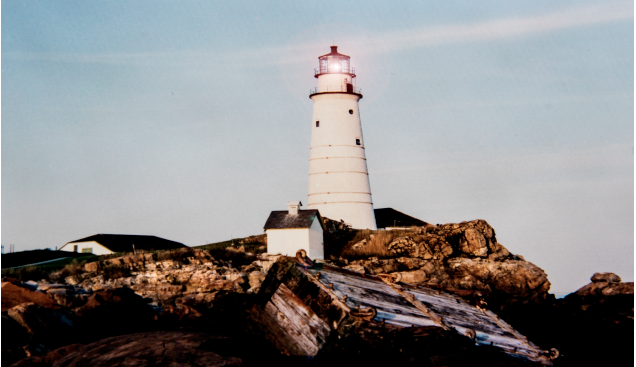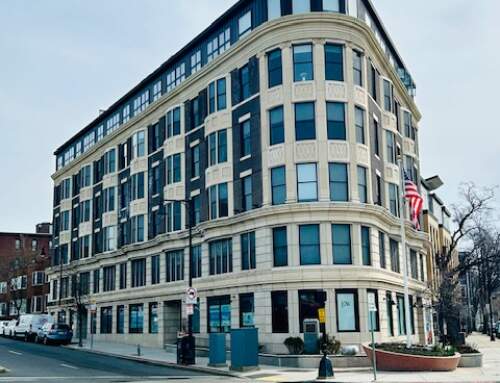By Richard Campbell
To contemporary visitors Boston Light is an historical tourist attraction that greets boats to the Boston Harbor from Little Brewster Island, but for so many Bostonians it is a point of pridebeing the first and last lighthouse station in the nation. The greater history of Boston Light reveals a complex technological, social and political evolution; making it more than one of the critical symbols of our nation’s founding. For past generations, the light was not merely a welcoming beacon, but a key navigational aid that often made the difference between life and death for seafaring crews sailing into the risky waters of Nantasket Roads, the primary entrance channel of Boston Harbor. Sea trade was naturally the lifeblood of the new colony: providing supplies to sustain existence, bringing more settlers, serving the grotesquely profitable triangular slave trade, and increasingly, until after the revolution-a symbol of the British stronghold. By the early 1700’s it had become obvious to colonists, influenced by Europe, that some kind of navigational device was needed to guide ships. The town of Hull that owned Little Brewster island, and the residents thereof, largely provided the impetus for establishing Boston Light’s location. Dozens of ships had gone down in this area of Boston harbor so that by 1715, the Massachusetts general court passed a lighthouse bill instructing the colony to erect a lighthouse for the protection of commerce and lives. According to Edward Rowe Snow’s seminal work: The Islands of Boston Harbor, the colonial government procured George Worthylake, a Boston Harbor Pilot, as the first lighthouse keeper in June 1716, and he was paid fifty pounds a year for his services. It is a noteworthy demonstration of how dangerous the waters were, when even an experienced boater like Worthylake was no match for the sea around the Brewster’s. His family and servants drowned in the harbor’s bone chilling November waters in 1718. The second lighthouse keeper, Robert Saunders, (according to the same account) did not fare too well either- drowning almost as soon as he arrived. It is hard for us today with advanced navigational tools, and powered boats with communication equipment, to imagine the danger of ocean sailing navigation at night in rocky waters of unknown depths utilizing only rough maps. But Boston Light hit pay dirt with the third lighthouse keeper John Hayes, who is accredited with many innovations and also living long enough to retire in 1733. No sooner than Boston Light was solidly on its feet, the American Revolution began. The British clearly had difficulty keeping a firm grip on Boston Light when they took it over in 1774. In 1775 Patriot troops, under the direction of Major Voss removed the lights from the tower and set fire to its interior to prevent the British from using it. Subsequently British troops landed on Brewster island to rebuild the lighthouse, but faced two well planned attacks under the leadership of General Benjamin Tupper. Tupper hounded the Brits in the battle of Boston Light, to the delight of Washington. With some 300 patriot troops they overcame the British control- burning the interior once again. These enormous efforts on the part of the colonists reveal the importance of controlling Boston Light to the revolutionary cause. Washington’s strategy of fortifying Dorchester Heights and continually attacking Boston Light proved very effective. By 1776 when they were forced out of Boston, the British used a charge to blow up Boston Light, destroying the majority of the lighthouse upon leaving. Thus, Boston Light is the oldest lighthouse station in the nation, but not the oldest lighthouse- as it was rebuilt in 1783, close to the original height. It is notable that in 1789 all lighthouses in the nation were put under federal control of the Treasury Department, creating the US Lighthouse Establishment, a precursor to the Coast Guard, and thus in 1790 Massachusetts by law officially ceded control of Boston Light to the federal government. The accretion of technologies since the first establishment of Boston light until today is a geek’s paradise: from fog signal cannons, trumpets, and bells, to various oil lamps, lightning rods, steam sirens, to the more modern fresnel lens, electrification, and sophisticated mechanical motors.

The first and last lighthouse station in the nation, Boston Light is the only Coast Guard staffed lighthouse in the United States.
The Light reveals continual technological upgrades to the current day tower, and when you climb its metal steps you can get a feeling for the improvements first hand, as well as what it must have been like in the old days of running up and down its stairs with just a lantern to see and set things in motion. It was really in 1812 Boston Light started its true upgrade to the technologically innovative Parisian Argand-type lamp with a hollow wick that burned with less smoke, was more efficient than plain wicks that used whale oil, and sported a reflector to intensify the light. Even though the Fresnel lens- (a model similar to the one invented by Augustin-Jean Fresnel) which greatly magnified light sources, was available as early as 1822, Boston Light did not install one until 1859, thus increasing its visibility to 16 miles. Some would say the delay was typical Yankee penny pinching, but things in the colonies were not moving at the speed of Europe in those days. With the installation of the rotating second order Fresnel lens the tower was raised to accommodate its size and weight. In 1877 the lighthouse upgraded from whale oil to mineral oil (kerosene), then to vapor lamps in 1913. Throughout the 1920’s lighthouses in the US were converted to electricity, Boston light didn’t make that move until 1948. By then the US Lighthouse service had absorbed into the US Coast Guard in 1939, and the sun was setting on the whole invention. The ostensible reason for the late electrification given by a few sources was that getting rid of the oil and wicks and mechanical motors basically obviated the need for a lighthouse keeper. But it must be said that given the order of island maintenance carried out by our current lighthouse keeper Sally Snowman, that argument seems kind of weak. The unit in the mechanical room that holds the two- ton mechanism sports some pretty advanced engineering technology from motorized rotation devices, to the 1,000watt bulb, emitting 2 million candle power flashes through a lenses to make that light shine to 25 miles away – this makes Boston Light as impressive to see up close as it is difficult to keep in working order. That being said that the period heading out of World War II advanced so many technologies for navigation, that lighthouses were seen as oddities more than navigational aids. If you want an incredible thrill arrange a boat ride to see Boston Light at nightit is astounding. We should be thankful that history has been preserved, in large part because of a bill passed in Congress by the late Senator Edward Kennedy, to keep the lighthouse staffed into perpetuity. Between the Coast Guard, the National Park Service, and the efforts of many volunteers, the Light shines on bright. Happy Birthday, Boston Light.






